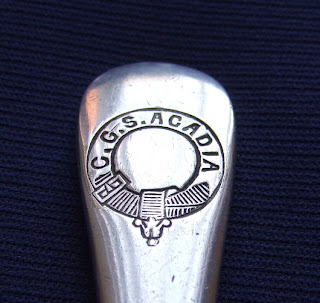This beautiful custom-engraved silver plate table spoon once graced the dining room aboard Acadia where the chartmakers and officers dined in Edwardian splendour. While other parts of the crew ate from tin plates, the top of the ship's hierarchy enjoyed fine china, crystal and silverware, all engraved with the ship's coat of arms.
2) Acadia's chartmakers finishing a meal aboard the ship in 1913, resplendent in luxury even while anchored on the barren shores of Hudson Bay. Note a silver spoon by the sugar bowl on the right.
However through some misadventure the spoon went overboard from Acadia. It was dragged up out of the ocean from waters east of Halifax, near the Liscomb Buoy by fisherman Charles H. Morris (1897-1955). The spoon was packed inside a box which likely accounts for its fine condition. Acadia charted in this area from 1919 to 1922 and also steamed by Liscomb en route to charting elsewhere.
3) The spoon after gentle polishing by museum registrar Lynn-Marie Richard.
Laura Morris, the wife of Charles Morris, gave the spoon to neighbours in Liscomb, Mary and James R. Pye. In 1959, Mrs. Pye donated the spoon to the Public Archives of Nova Scotia. Carefully looked after for years by archival assistant Darlene Brine, the spoon was transferred to the Maritime Museum of the Atlantic in 2004. We were delighted when the spoon came to our collection allowing us to re-unite it with the spoon's old home, CSS Acadia.
4) Museum interpreter Jeanne Church as the spoon returns to Acadia decades after falling overboard.
Those fond of artifact detective work can trace the spoon's history from the markings on the back. They contain the hallmark "W&H" of the firm Walker and Hall of Sheffield, England. There is also a date letter, the Gothic letter "U", used by the firm to show that the spoon was made in 1912. This means the spoon was part of Acadia's original outfit of silverware, ordered while the ship was still under construction before her launch in 1913. Walker and Hall also supplied some of the 44,000 pieces of cutlery which sank with RMS Titanic in 1912. Perhaps this spoon crossed paths at the W&H factory in Sheffield with silver headed for Titanic, a more famous but far less successful ship than Acadia!
4) Reverse of spoon showing markings
The Archives and Museum have also added their own layers of identity, painted in ink on reversible nail polish. You can see the old catalogue number from the Nova Scotia Archives "31.07" and right beside it the accession number of the Maritime Museum of the Atlantic, "M2004.50.7"
Museums are all about telling stories with objects and this little spoon and its trip through time is a fine example. In a way, a spoon that rose from the bottom of the ocean is an appropriate relic to associate with Acadia, as she is a chartmaking ship that spent her career coaxing information from the sea bottom to ensure that others traveled safely.





No comments:
Post a Comment